China Ready To Drink Coffee Market Size
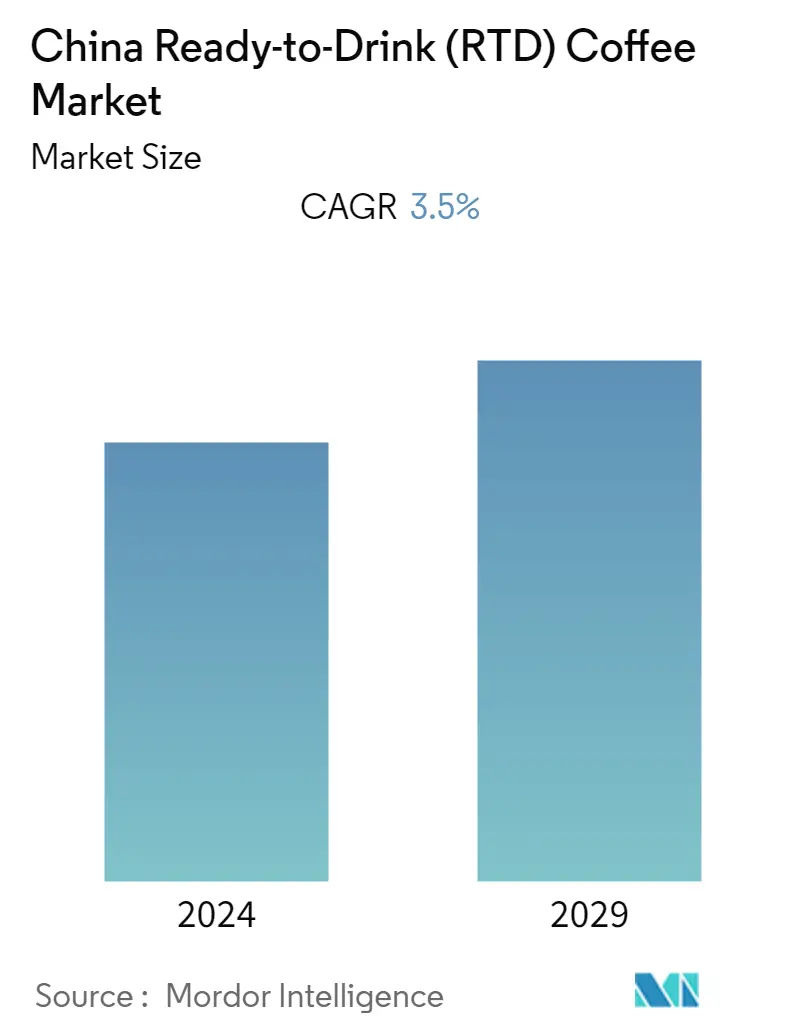
| Study Period | 2019 - 2029 |
| Base Year For Estimation | 2023 |
| Forecast Data Period | 2024 - 2029 |
| Historical Data Period | 2019 - 2022 |
| CAGR | 3.50 % |
| Market Concentration | Low |
Major Players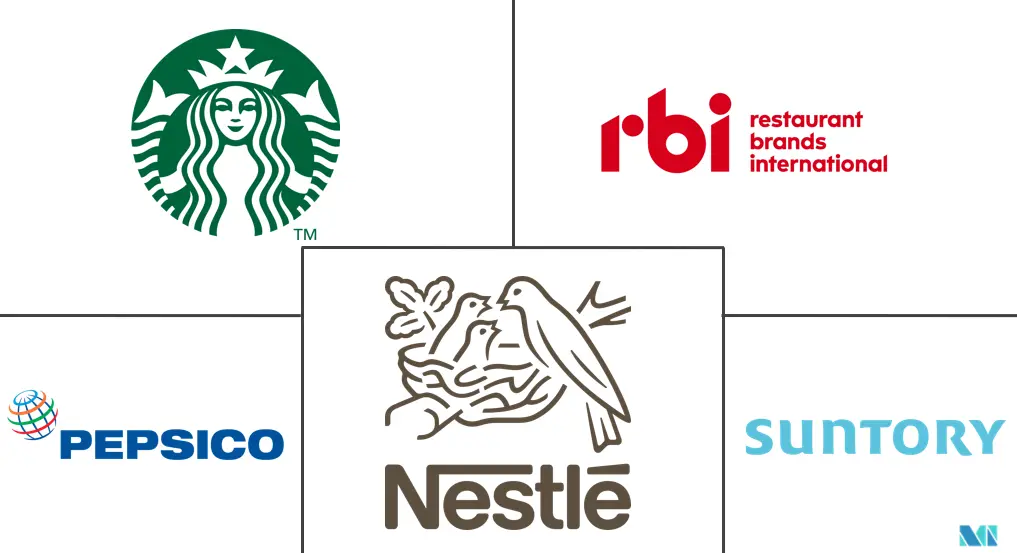
*Disclaimer: Major Players sorted in no particular order |
China Ready To Drink Coffee Market Analysis
China's Ready-to-Drink (RTD) Coffee Market is projected to grow at a CAGR of 3.5% over the forecast period.
Coffee consumption in China is highly concentrated in large cities such as Beijing, Shanghai, and Guangzhou. Recently, coffee has appealed to adventurous young, rich, and urban consumers. This is because, originally, coffee is considered a Western concept by most Chinese consumers. Manufacturers have targeted Westernized young professionals as the main target market for RTD coffee. Many consumers were ordering their coffee online, increasing the consumption of at-home coffee, or increasingly purchasing ready-to-drink coffee. Owing to the hectic work-from-home culture during the lockdown, the demand for ready-to-drink (RTD) increased rapidly.
Ready-to-drink (RTD) coffee appeals to many consumers, contributing to its growth. There has been an increase in cold coffee consumption by Gen X consumers, but the primary consumers are young people. Functional RTD coffee provides an opportunity for brands that can differentiate themselves through health claims. Consumers are looking for coffees that offer many functional benefits, such as antioxidants, anti-inflammatory, low sugar, added protein, probiotics, and low caffeine and high caffeine. Moreover, dairy-free and vegan coffee are also increasingly being launched to deliver on both convenience and healthy on-the-go beverage categories.
China Ready To Drink Coffee Market Trends
Growing Preference for Coffee Over Tea
The demand for convenience food and beverage, particularly RTD coffee, is growing at a faster pace due to changes in social and economic patterns, as well as increased expenditure on food and beverage, awareness about healthy foods, changes in meal patterns, and existing food habits, and the desire to taste new products. Healthy beverages are necessary for fitness-oriented consumers who consume meals frequently throughout the day. Hence, the demand for healthy RTD coffee products is gaining traction among consumers. Consumers in China prefer coffee over tea as it appeals to adventurous young, rich, and urban consumers. This is because, initially, coffee is considered a Western concept by most Chinese consumers.
Manufacturers have targeted Westernized young professionals as the main target market for RTD coffee. Another large consumer group that influences RTD coffee consumption is returnees. Many of these returnees have lived in Western countries for a decade and have become accustomed to the RTD coffee culture. Upon returning to China, they continue living as they have become used to. Foreign expatriates make up a large proportion of coffee consumers in China. According to USDA Foreign Agricultural Service, in the coffee crop year 2021/22, the Chinese population consumed around 4.2 million 60-kilogram bags of coffee. Moreover, a significant portion of the population has access to easy on-the-go beverage options due to the increased penetration of these products in the market. Since the transforming consumer habits promote smaller frequent meals, consumers tend to buy RTD coffee more often, which is expected to propel the market in the forecast period.
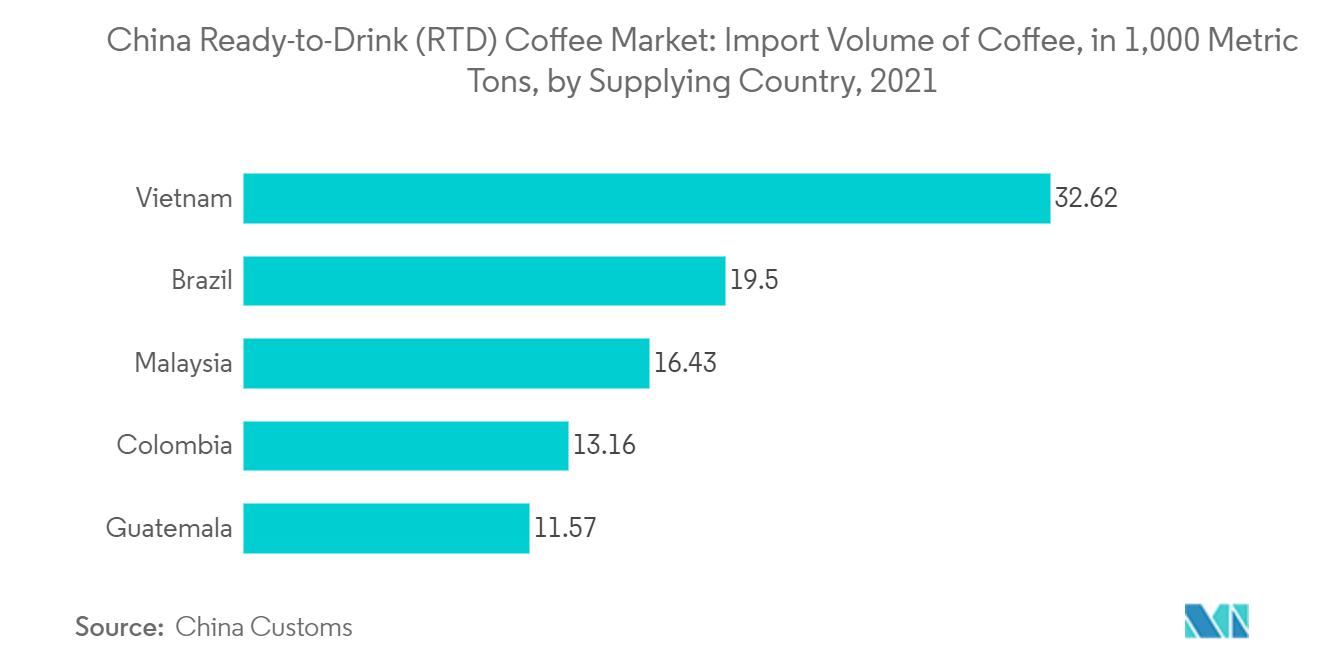
Increase in Number of Specialty Stores
Coffee consumption is increasing in China and will increase during the forecast period. There is a trend toward a coffee culture developed over the last decade mainly due to the influence of Cosmopolitan Beijing and Shanghai. Coffee Chains like Starbucks have been pushing coffee culture onto young people, who now enjoy hanging out and drinking with friends in coffee shops. Further health awareness among educated consumers with comparatively strong consumption is interested in purchasing coffee in Speciality stores. According to the China General Chamber of Commerce, in 2021, specialty stores in China recorded a sales value of around USD 0.30 trillion.
Recently, coffee shops witnessed tremendous growth as outlets gained popularity as hangout zones for friends, family, colleagues, and business associates. The increased acceptance of coffee is attributed to the emergence of premium stores from companies such as Starbucks Corporation and Tim Hortons, fueling the market growth. Starbucks Corporation continued accelerating its expansion in China, opening 6,000 stores in 2022, an increase from 5,135 stores in 2021. Moreover, these outlets have ushered in an experiential element to coffee drinking by creating an attractive and relaxing ambiance.Additionally, changing work patterns of business executives are also driving demand for coffee shops/cafes, as these outlets offer services such as free Wi-Fi, entertainment zones, etc. With this growing coffee shop trend, there is a rise in the number of specialty stores in China, which will propel the RTD coffee market during the forecast period.
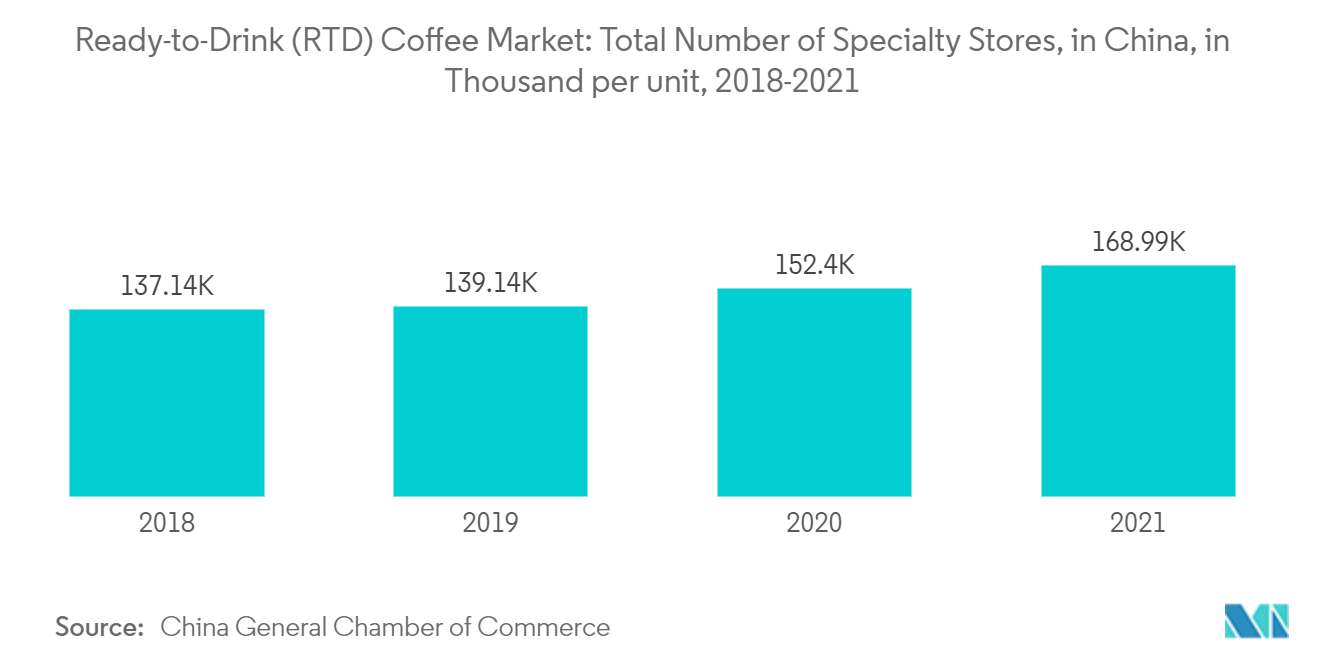
China Ready To Drink Coffee Industry Overview
China's ready-to-drink tea (RTD) coffee market is highly fragmented, with key players such as Nestle SA, Starbucks Corporation, Suntory Holdings Ltd, PepsiCo Inc., and Restaurant Brands International Inc. (Tim Hortons). The key strategies adopted by the players in the market are expansions, innovations, and new product launches. Companies compete on different factors, including other ingredient-based product offerings, quality, and ability to scale to gain a competitive advantage.
China Ready To Drink Coffee Market Leaders
-
Nestle S.A
-
Starbucks Corporation
-
Suntory Holdings Ltd.
-
PepsiCo, Inc.
-
Restaurant Brands International Inc. (Tim Hortons)
*Disclaimer: Major Players sorted in no particular order
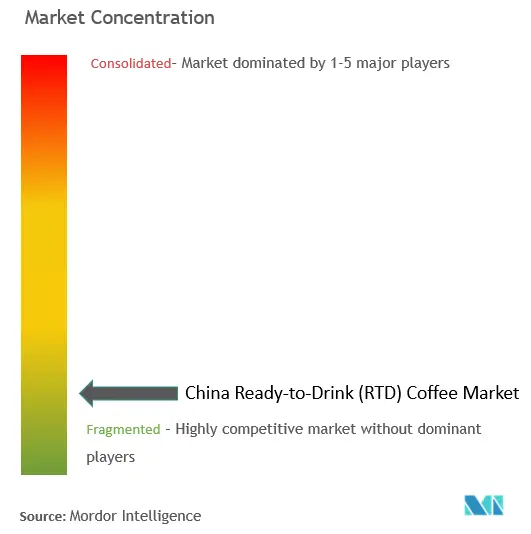
China Ready To Drink Coffee Market News
- In September 2022, a convenience store in China, Sinopec's Easy Joy, and Tim Horton's International Limited, the exclusive operator of Tim Hortons coffee shops in China, partnered and launched two co-branded ready-to-drink coffee products.
- In September 2021, the Chinese restaurant chain Yum China and Italian coffee maker Lavazza aimed to open 1,000 Lavazza cafés in China by 2025. The two groups invested USD 200 million initially into the joint venture to fund its future growth. In addition, the joint venture will market, sell, and distribute Lavazza's retail products, including RTD coffee, in mainland China under an exclusivity agreement.
- In April 2021, Nestlé invested in a new RTD coffee product innovation center in China. The investment included establishing a product innovation center to develop Nescafé ready-to-drink coffee, liquid dairy, and other products.
China Ready To Drink Coffee Market Report - Table of Contents
1. INTRODUCTION
- 1.1 Study Assumptions and Market Definition
- 1.2 Scope of the Study
2. RESEARCH METHODOLOGY
3. EXECUTIVE SUMMARY
4. MARKET DYNAMICS
- 4.1 Market Drivers
- 4.2 Market Restraints
-
4.3 Porter's Five Forces Analysis
- 4.3.1 Threat of New Entrants
- 4.3.2 Bargaining Power of Buyers/Consumers
- 4.3.3 Bargaining Power of Suppliers
- 4.3.4 Threat of Substitute Products
- 4.3.5 Intensity of Competitive Rivalry
5. MARKET SEGMENTATION
-
5.1 Packaging Type
- 5.1.1 Bottles
- 5.1.2 Can
- 5.1.3 Other Packaging Types
-
5.2 Distribution Channel
- 5.2.1 Supermarkets/Hypermarkets
- 5.2.2 Convenience Stores
- 5.2.3 Foodservice Channels
- 5.2.4 Online Retail Stores
- 5.2.5 Other Distribution Channels
6. COMPETITIVE LANDSCAPE
- 6.1 Most Adopted Strategies
- 6.2 Market Share Analysis
-
6.3 Company Profiles
- 6.3.1 Nestle SA
- 6.3.2 Starbucks Corporation
- 6.3.3 Suntory Holdings Ltd
- 6.3.4 Uni-President Enterprises Corp.
- 6.3.5 The Coca-Cola Company
- 6.3.6 Tsing Hsin International Group
- 6.3.7 PepsiCo Inc.
- 6.3.8 Restaurant Brands International Inc. (Tim Hortons)
- 6.3.9 Asahi Group Holdings Ltd
- 6.3.10 Arla Foods amba
- *List Not Exhaustive
7. MARKET OPPORTUNITIES AND FUTURE TRENDS
** Subject To AvailablityChina Ready To Drink Coffee Industry Segmentation
Ready-to-drink coffee is a cold drink that comes pre-made in a can or a bottle and is a quick takeaway option for lunches. China's ready-to-drink (RTD) coffee market is segmented by packaging type and distribution channel. Based on the packaging type, the market is segmented into bottles, cans, and other packaging types. Based on the distribution channel, the market is segmented into supermarkets/hypermarkets, convenience stores, foodservice channels, online retail stores, and other distribution channels. The report offers market size and forecasts in value (USD million) for the above segments.
| Packaging Type | Bottles |
| Can | |
| Other Packaging Types | |
| Distribution Channel | Supermarkets/Hypermarkets |
| Convenience Stores | |
| Foodservice Channels | |
| Online Retail Stores | |
| Other Distribution Channels |
China Ready To Drink Coffee Market Research FAQs
What is the current China Ready-to-Drink (RTD) Coffee Market size?
The China Ready-to-Drink (RTD) Coffee Market is projected to register a CAGR of 3.5% during the forecast period (2024-2029)
Who are the key players in China Ready-to-Drink (RTD) Coffee Market?
Nestle S.A, Starbucks Corporation, Suntory Holdings Ltd., PepsiCo, Inc. and Restaurant Brands International Inc. (Tim Hortons) are the major companies operating in the China Ready-to-Drink (RTD) Coffee Market.
What years does this China Ready-to-Drink (RTD) Coffee Market cover?
The report covers the China Ready-to-Drink (RTD) Coffee Market historical market size for years: 2019, 2020, 2021, 2022 and 2023. The report also forecasts the China Ready-to-Drink (RTD) Coffee Market size for years: 2024, 2025, 2026, 2027, 2028 and 2029.
China RTD Coffee Industry Report
Statistics for the 2024 China RTD Coffee market share, size and revenue growth rate, created by Mordor Intelligence™ Industry Reports. China RTD Coffee analysis includes a market forecast outlook 2029 and historical overview. Get a sample of this industry analysis as a free report PDF download.



